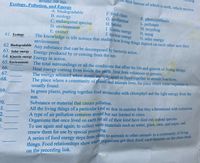
Human Anatomy & Physiology (11th Edition)
11th Edition
ISBN: 9780134580999
Author: Elaine N. Marieb, Katja N. Hoehn
Publisher: PEARSON
expand_more
expand_more
format_list_bulleted
Concept explainers
Question
I need your help with the questions between 66-75. These are matching questions, so all you need to do is matching the definitions with the given words and nothing more! PLEASE MATCH THEM BETWEEN 66-75.
Thanks!

Transcribed Image Text:Ing
most famous of which is earth, which revolve
áround our sun.
Ecology, Pollution, and Energy
F. food chain
G. geothermal
H. habitat
I. Kinetic energy
J. nuclear energy
The knowledge or life science that studies how living things depend on each other and their
A. biodegradable
B. ecology
C. endangered species
D. environment
E. extinct
K. photosynthesis
L. pollutant
M. recycling
N. smog
O. solar energy
61. Ecology
environment.
62. Biodegradable Any substance that can be decomposed by bacterial action.
63. Solar energy Energy produced by or coming from the sun.
64. Kinectic energy Energy in action.
The total surroundings or all the conditions that effect the life and growth of living things.
Heat energy coming from inside the earth. Heat from volcanoes or geysers.
The energy released when atoms are split apart or fused together in atomic reactions.
The place where a community of plants and animals lives; the place where some organism is
65. Environment
66.
67.
68.
usually found.
In green plants, putting together food molecules with chlorophyll and the light energy from the
69.
sun.
70.
1.
2.
3.
1.
Substance or material that causes pollution.
All the living things of a particular kind so few in number that they a threatened with extinction.
A type of air pollution common around but not limited to cities.
Organisms that once lived on earth but all of their kind have died out; a dead species.
To use again and again; to collect waste materials such as water, glass, cans, and paper, and
renew them for use by special processing.
A series of food energy steps from plants to animals to other animals in a community of living
things. Food relationships show where organisms get their food; each member on the chain feeds
on the preceding link.
Expert Solution
This question has been solved!
Explore an expertly crafted, step-by-step solution for a thorough understanding of key concepts.
This is a popular solution
Trending nowThis is a popular solution!
Step by stepSolved in 2 steps with 1 images

Knowledge Booster
Learn more about
Need a deep-dive on the concept behind this application? Look no further. Learn more about this topic, biology and related others by exploring similar questions and additional content below.Similar questions
- Can someone please read the question very well and check my boxes if I have filled up correct. The first column was given, the blue color are my answers. Please check and let me know if correct if not please help me to fix it. Thank youarrow_forwardCan you please fill out the lane/well numberarrow_forwardThe correct answer is 2/3. Can you explain why?arrow_forward
arrow_back_ios
arrow_forward_ios
Recommended textbooks for you
 Human Anatomy & Physiology (11th Edition)BiologyISBN:9780134580999Author:Elaine N. Marieb, Katja N. HoehnPublisher:PEARSON
Human Anatomy & Physiology (11th Edition)BiologyISBN:9780134580999Author:Elaine N. Marieb, Katja N. HoehnPublisher:PEARSON Biology 2eBiologyISBN:9781947172517Author:Matthew Douglas, Jung Choi, Mary Ann ClarkPublisher:OpenStax
Biology 2eBiologyISBN:9781947172517Author:Matthew Douglas, Jung Choi, Mary Ann ClarkPublisher:OpenStax Anatomy & PhysiologyBiologyISBN:9781259398629Author:McKinley, Michael P., O'loughlin, Valerie Dean, Bidle, Theresa StouterPublisher:Mcgraw Hill Education,
Anatomy & PhysiologyBiologyISBN:9781259398629Author:McKinley, Michael P., O'loughlin, Valerie Dean, Bidle, Theresa StouterPublisher:Mcgraw Hill Education, Molecular Biology of the Cell (Sixth Edition)BiologyISBN:9780815344322Author:Bruce Alberts, Alexander D. Johnson, Julian Lewis, David Morgan, Martin Raff, Keith Roberts, Peter WalterPublisher:W. W. Norton & Company
Molecular Biology of the Cell (Sixth Edition)BiologyISBN:9780815344322Author:Bruce Alberts, Alexander D. Johnson, Julian Lewis, David Morgan, Martin Raff, Keith Roberts, Peter WalterPublisher:W. W. Norton & Company Laboratory Manual For Human Anatomy & PhysiologyBiologyISBN:9781260159363Author:Martin, Terry R., Prentice-craver, CynthiaPublisher:McGraw-Hill Publishing Co.
Laboratory Manual For Human Anatomy & PhysiologyBiologyISBN:9781260159363Author:Martin, Terry R., Prentice-craver, CynthiaPublisher:McGraw-Hill Publishing Co. Inquiry Into Life (16th Edition)BiologyISBN:9781260231700Author:Sylvia S. Mader, Michael WindelspechtPublisher:McGraw Hill Education
Inquiry Into Life (16th Edition)BiologyISBN:9781260231700Author:Sylvia S. Mader, Michael WindelspechtPublisher:McGraw Hill Education

Human Anatomy & Physiology (11th Edition)
Biology
ISBN:9780134580999
Author:Elaine N. Marieb, Katja N. Hoehn
Publisher:PEARSON

Biology 2e
Biology
ISBN:9781947172517
Author:Matthew Douglas, Jung Choi, Mary Ann Clark
Publisher:OpenStax

Anatomy & Physiology
Biology
ISBN:9781259398629
Author:McKinley, Michael P., O'loughlin, Valerie Dean, Bidle, Theresa Stouter
Publisher:Mcgraw Hill Education,

Molecular Biology of the Cell (Sixth Edition)
Biology
ISBN:9780815344322
Author:Bruce Alberts, Alexander D. Johnson, Julian Lewis, David Morgan, Martin Raff, Keith Roberts, Peter Walter
Publisher:W. W. Norton & Company

Laboratory Manual For Human Anatomy & Physiology
Biology
ISBN:9781260159363
Author:Martin, Terry R., Prentice-craver, Cynthia
Publisher:McGraw-Hill Publishing Co.

Inquiry Into Life (16th Edition)
Biology
ISBN:9781260231700
Author:Sylvia S. Mader, Michael Windelspecht
Publisher:McGraw Hill Education